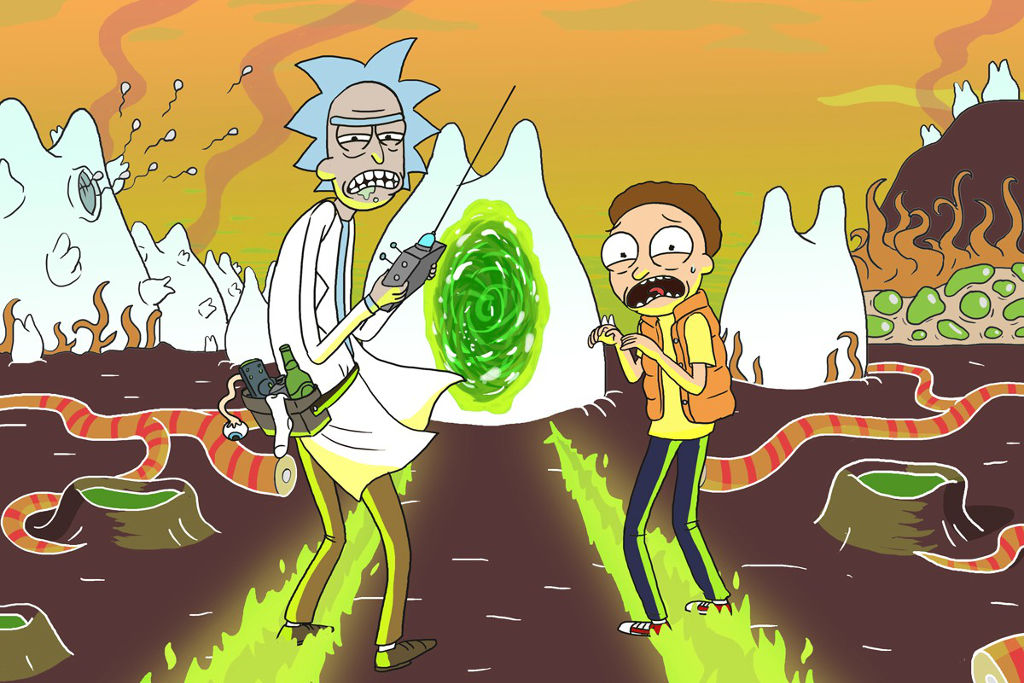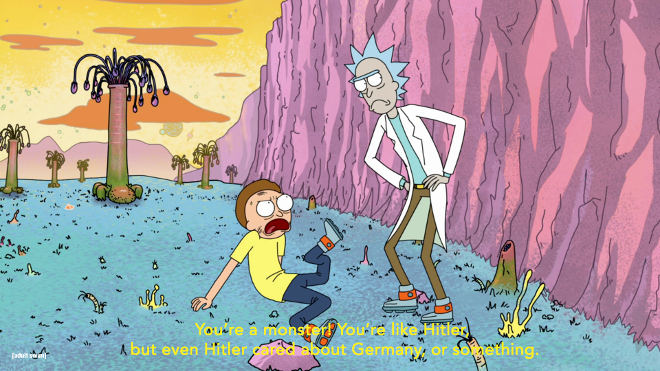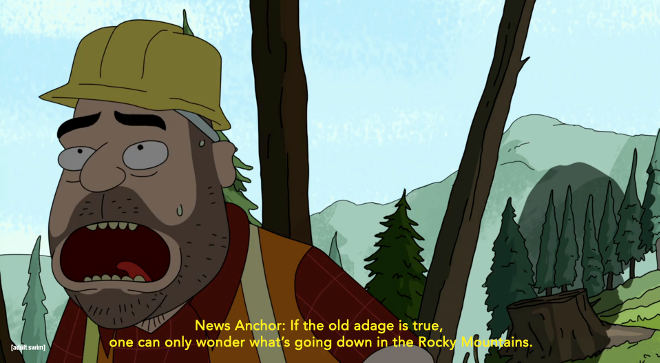The Mad Genius Of Adult Swim’s ‘Rick And Morty’
Season two just premiered in the USA. You really should be watching this show.

We’re all familiar with the riotous, irreverent and often disturbing antics of the Cartoon Network’s weird cousin, Adult Swim. It’s the station responsible for the likes of The Venture Bros., Harvey Birdman, Children’s Hospital, Robot Chicken and those terrifying infomercials — you know, immature, dark and bizarre; those kinds of shows.
But one of those shows, while it is all of those things, layers on a moral and structural complexity you only really see on the prestige cable networks, while using itself as a platform for discussion about the place science has in contemporary society.
That sounds overstated and a little hyperbolic, but Rick and Morty — which returned for its second season on Sunday night — is a deviously clever animated show.
The basic premise of Rick and Morty is never really explained, but based on its visual touchstones, you can only assume the idea was to ground Back To The Future in the drama of a dysfunctional suburban family. Rick is the mad scientist: grey hair shooting out of his scalp like lightning bolts, constantly robed in a scientist’s coat — he’s basically Doc Brown, if the Doc developed a serious drinking habit and flung himself headlong into misanthropy. Morty is Rick’s nervous, self-conscious 14-year-old grandson, his voice constantly breaking as he grapples with the ramifications of time travel (just like Marty McFly, get it?). Rick’s complete disregard for the wellbeing of his grandson allows him to throw the duo into dangerous inter-dimensional adventures.

The series was created by Community sometimes-showrunner Dan Harmon and voice actor Justin Roiland (Fish Hooks, Adventure Time). The pair make a mind-bogglingly creative team, fusing high-concept sci-fi with a clever wit and surprisingly touching human drama. Harmon’s penchant for perfectly-functioning meta worlds is on full display here. While Community used pop culture templates to tell stories about its characters, every episode of Rick and Morty uses sci-fi ideas as its foundation — Fantastic Voyage, Inception, The Matrix — to say something meaningful about how we interact with science in pop culture. Hiding all of this juicy commentary in its familiar sci-fi mechanics lets the show put all of its zany comedy up front, and notches up the rewatchability of each episode, too. It may look and act like an insane Back To The Future, but it’s the social analyses built into each episode that gives Rick and Morty a distinctive edge.
‘Something Ricked This Way Comes’ — an episode in which has Rick goes head to head with The Devil in a business showdown — offers the perfect example. While having only 19 minutes to seriously tackle the battle between religion and science would prove surprisingly progressive for most other animated shows, Rick and Morty’s writers take it one further, seamlessly layering a critique on consumer culture into the mix. Morty’s sister, Summer, is working in the Devil’s shop; when challenged about the morality of working with Satan, she replies with a line worthy of its own t-shirt:
There’s a cavalcade of jokes on jokes, on jokes. A story isn’t finished if its gags aren’t played out to their furthest possible conclusion. In the episode ‘Anatomy Park’, Rick blows a naked Santa up to 1000x times his normal size (for reasons too hilariously convoluted to delve into), who then floats menacingly across the width of the United States. The episode quickly cuts to a news anchor throwing to reporters across the country, who explain what massive body part is crossing their skies. “We’ve got feet here on the West Coast, Bill. Giant feet, even relative to the giant man’s size. And you know what they say about that!”
Cut to:

The show doesn’t skimp on confronting character stuff either. There’s a moment in ‘Rick Potion #9’ where Rick and Morty burst into an alternate dimension and find out their alternate selves were both killed in a laboratory experiment gone wrong. With the entrails of their others splattered all over the walls, Rick tells Morty they have to bury the dead bodies and replace them in this dimension. Instead of cutting to a joke that distances you from what would otherwise be a horrific Cronenbergian situation, the show follows Morty’s mortified face through a truly sad montage as he buries his own eviscerated remains and sits down on the couch, his eyes blank.
It’s a moment that’s both hilarious and deeply disturbing, a perfect example of the intersection between big ideas, flippancy and wit that the show excels at.
While Rick maybe representative of the show’s love of a scientific point of view, he’s also an asshole. Instead of wielding his mad genius for the good of his family and those around him, he uses it for selfish means, or, more often, in defense of his ego. That’s the beauty of the series — it doesn’t take anything more seriously than Rick would. That’s not a huge feat of ingenuity by any stretch, but it does the whole “adult animated show” thing perfectly: it trusts that its audience gets the subtext.
“I think that’s a really remarkable thing about today’s TV audience. You cannot write payoff-based TV anymore because the audience is essentially a render farm. They have an unlimited calculation capacity. There’s no writers’ room that can think more than 20 million people who can think about it for an hour a day,” says Harmon in an interview with The A.V. Club, “You can’t try to fool the audience.”
South Park copped a lot of flack in its heyday for its foul-mouthed antics. Young parents saw the colourful animation and assumed it was intended for their children. Moral panic soon followed and, for ’90s kids, the show became a sort of TV taboo, one that you’d smuggle to your friends’ houses and watch when their parents weren’t home. Eventually, the dust settled and everybody regained their senses. Audiences started to see the layers of ingenious satire weaved into each episode. When the show is mentioned nowadays, it’s always with a bit of reverence: a popular animated show that actually had something to say about politics, the media and the pop culture world it lived in. Those first audiences weren’t watching the show to see what it was actually saying; they simply glimpsed superficial details, and labelled it reflexively.
But it’s 2015 now and we’ve gotten so much better at watching TV. It’s why shows like The Sopranos or Mad Men get such loyal followings; audiences have learned how to read and deconstruct their favourite shows. Hopefully, the same applies to Rick and Morty. Its surface-level qualities — crude animation; over-the-top voice acting — is likely to have turned some viewers off immediately, but they’d be missing the forest for the trees. It’s an exceptionally well-made show and, the more you dissect it, the more you find it has to say.
And if that doesn’t convince you, here’s a great bit titled, “Abradolf Lincler”:
–
Rick and Morty’s first season is airing on Foxtel’s Comedy Channel on Mondays at 9.30pm; season two began last night on America’s Adult Swim, but is not yet available to watch or stream in Australia.
–